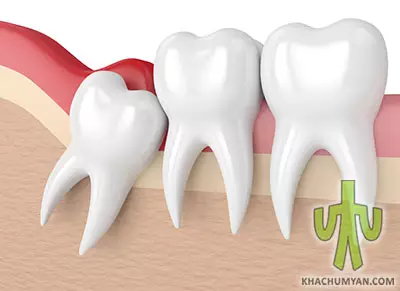Wisdom teeth are the 8th teeth in the dentition, which usually appear mainly after 18. The wisdom teeth are named for their late appearance. They are considered to be the most unpredictable and useless teeth. They can cause many problems; therefore, it is generally recommended to remove these teeth.
Why is wisdom tooth removal often prescribed?

- First of all, the so-called "hood" often appears when wisdom teeth appear. This is a layer of mucous membrane that partially covers the crown of the wisdom tooth. Bacteria and food debris often accumulate under this layer of a mucous membrane, which causes inflammation, which in turn bothers the patient in the form of pain and swelling.
- Secondly, there are very few cases when there is not enough space for a wisdom tooth in the dentition, which is why it bends either on the side of the cheek or on the side of the tongue or leans on the 7th tooth. For example, when a wisdom tooth bends into the cheek of the tooth side, it often hurts the cheek while chewing. Also, under the pressure of the wisdom teeth appearance, the teeth move, and the dentition goes under several changes.
- Thirdly, due to the wisdom tooth's very back position, it isn't easy to maintain proper hygiene. And as it is known, due to incomplete hygiene, caries can occur, and the crown of the tooth decays; the wisdom tooth is not an exception. The only thing that makes a wisdom tooth different from other teeth is its unpredictability. If in the case of caries complications, the pulp (nerves) becomes inflamed, in the case of wisdom teeth, it is accompanied by terrible spreading pain and swelling. Due to these teeth complex topographical anatomy, the complete anesthesia of inflamed tissues is challenging to achieve.
Given all this, it is not surprising that doctors would instead remove these teeth in many cases. The decision to treat rarely happens because it should be realized that the wisdom teeth don't have chewing function; moreover, they do not perform any function. Does it make sense to treat those teeth? In addition, it is difficult to talk about quality treatment due to complex anatomy. It is often very challenging for a dentist to reach that tooth with tools and maintain the dryness that is necessary both while filling and elaborating the root canals.
How do they remove wisdom teeth?
 X-ray diagnostics: It is performed before removal to get an idea of the roots position and the degree of difficulty of the removal. The process of removing these teeth due to unpredictability can be different depending on the cases, methods, and time.
X-ray diagnostics: It is performed before removal to get an idea of the roots position and the degree of difficulty of the removal. The process of removing these teeth due to unpredictability can be different depending on the cases, methods, and time.
Anesthesia: Wisdom tooth extraction is performed under local anesthesia.
Extraction: This process can last up to 15 minutes and sometimes hours as there may be need to separate tooth roots from each other and extract them part by part. The anesthesia is included in that process.
Stitches: After the wisdom tooth is removed, the wound may need to be sewed (2-3 stitches). All this sounds very difficult and scary, but the doctor does all this, and the patient even doesn't notice anything. After 3-5 days, the stitches are removed.
Consequences: Swelling of soft tissues can develop after the removal of wisdom teeth. To avoid complications, follow your doctor's prescriptions and instructions properly. No matter how well you feel, you need to visit a doctor on the appointed day.



